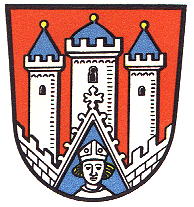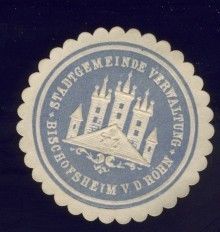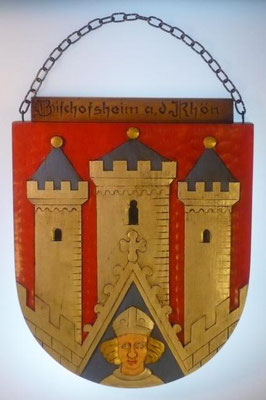Bischofsheim an der Rhön: Difference between revisions
Knorrepoes (talk | contribs) m (Text replacement - "{{media}}" to " {{de1}} {{media1}}") |
Knorrepoes (talk | contribs) m (Text replacement - "{{de}}" to "") |
||
| Line 1: | Line 1: | ||
'''BISCHOFSHEIM AN DER RHÖN''' | '''BISCHOFSHEIM AN DER RHÖN''' | ||
Revision as of 14:06, 26 December 2022
BISCHOFSHEIM AN DER RHÖN
State : Bayern
District (Kreis) : Rhön-Grabfeld (until 1973 Bad Neustadt an der Saale)
Additions : 1972 Wegfurt; 1975 Haselbach in der Rhön; 1978 Frankenheim, Oberweißenbrunn, Unterweißenbrunn
| German |
In Rot eine silberne Befestigung mit drei blau bedachten silbernen Zinnentürmen; unter wimpergartigem Torbogen in Blau der Kopf eines Bischofs mit silberner Mitra. |
| English | an der Rhön No blazon/translation known. Please click here to send your (heraldic !) blazon or translation |
Origin/meaning
The town became a city in the 14th century and the oldest seal also dates from this time. The seal, which has been used for over 500 years, shows the present image, although not in a shield. The head in the lower part may be the local patron saint, St.Kilian, or a canting bishop. In a few later and smaller seals a staff and sword were added to the bishop, which probably indicated the fact that the city at the time belonged to the State and Bishops of Würzburg. In the 19th century the present arms were restored and based on the oldest seal.
| Seal from around 1900 |
The arms by Hupp in the Kaffee Hag albums +/- 1925 |
| The arms in the Deutsches Wappenmuseum |
Literature: Stadler, 1964-1971, 8 volumes; Hupp, O: Kaffee Hag albums, 1920s



